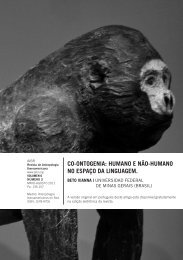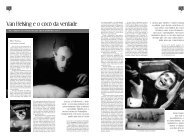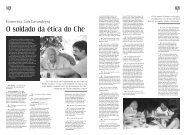Merleau-Ponty, 1964. Eye and mind. - Biolinguagem
Merleau-Ponty, 1964. Eye and mind. - Biolinguagem
Merleau-Ponty, 1964. Eye and mind. - Biolinguagem
- No tags were found...
Create successful ePaper yourself
Turn your PDF publications into a flip-book with our unique Google optimized e-Paper software.
Notes<br />
I. "L'oeil et l'esprit" was the last work <strong>Merleau</strong>-<strong>Ponty</strong> saw published. It appeared in the inaugural<br />
issue of Art de Frana I, no. I (January 1961). After his death it was reprinted in Les Temps<br />
Modemes 184-85, along with seven articles devoted to him. It has now been published, in book<br />
form, by Gallimard (1964). Both the Art de France article <strong>and</strong> the book contain illustrations chosen<br />
by <strong>Merleau</strong>-<strong>Ponty</strong>. According to Professor Claude Lefort, "L'oeil et l'esprit" is a preliminary<br />
statement of ideas that were to be developed in the second part of the book <strong>Merleau</strong>-<strong>Ponty</strong> was<br />
writing at the time of his death—Le visible et l'invisible (part of which was published posthumously<br />
by Gallimard in February 1964). The translator wishes to acknowledge his immense debt to George<br />
Downing, who spent many long hours working over the final revisions of the translation. Also,<br />
thanks are due to Michel Beaujour, Arleen B. Dallery, <strong>and</strong> Robert Reitter for their advice <strong>and</strong><br />
encouragement.—Trans.<br />
2. [II est là, fort ou faible dans la vie, mais souverain sans conteste dans sa rumination du monde,<br />
sans autre "technique" que celie que ses yeux et ses mains se donnent à force de voir, à force de<br />
peindre, acharné à tirer de ce monde où sonnent les sc<strong>and</strong>ales et les gloires de l'histoire des toiles<br />
qui n'ajouteront guère aux colères ni aux espoirs des hommes, et personne ne murmure.]<br />
3. Cf. Le visible et l'invisible (Paris: Gallimard, 1964), 273, 308-11.-Trans. 4. See Signes (Paris:<br />
Gallimard, 1960),210,222-23, especially the footnotes, for a clarification of the "circularity" at issue<br />
here.—Trans.<br />
5. [Cet équivalent interne, cette formule charnelle de leur présence que les choses suscitent en<br />
moi, pourquoi à leur tour ne susciteraient—ils pas un tracé, visible encore, où tout autre regard<br />
retrouvera les motifs qui soutiennent son inspection du monde]<br />
6. G. Charbonnier, Le monologue du peintre (Paris, 1959), 172.<br />
7. [Beaucoup plus loin, puisque Ie tableau n'est un analogue que selon Ie corps, qu'il n'offre pas a<br />
l'esprit une occasion de repenser les rapports constitutifs des choses, mais au regard, pour qu'illes<br />
épouse, les traces de la vision du dedans, à la vision ce qui la tapisse intérieurement, la texture<br />
imaginaire du réel.]<br />
8. Charbonnier, Le monologue, 34.<br />
9. Ibid., 143-45.<br />
10. " . . . une philosophie figurée." Cf. Bergson (Ravaisson), note 46 below.—Trans.<br />
11. P. Claudel, Introduction à la peinture holl<strong>and</strong>aise (Paris, 1935).<br />
12. P. Schilder, The Image <strong>and</strong> Appearance of the Human Body (London, 1935; New York, 1950),<br />
223-24. ["the body-image is not confined to the borderlines of one's own body. It transgresses them<br />
in the mirror. There is a body-image outside ourselves, <strong>and</strong> it is remarkable that primitive peoples<br />
even ascribe a substantial existence to the picture in the mirror" (278). Schilder's earlier, shorter<br />
study, Das Körperschema (Berlin, 1923), is cited several times in The Structure of Behavior <strong>and</strong> in<br />
Phenomenology of Perception. Schilder's later work is of especial interest with regard to <strong>Merleau</strong>-<br />
<strong>Ponty</strong>'s own elaborations of the meaning of the human body; it is worth examining for that reason,<br />
as well as for the chance it provides to discern some fundamental coincidences between <strong>Merleau</strong>-<br />
<strong>Ponty</strong> <strong>and</strong> certain American pragmatists.]<br />
13. Cf. Schilder, Image, 281-82.-Trans.<br />
14. Robert Delaunay, Du cuhisme à l'art abstrait (Paris, 1957).<br />
20









